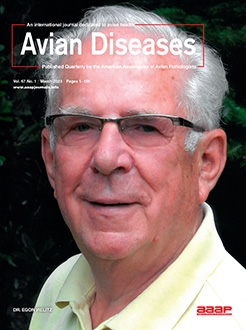Despite the essential role of innate immunity in defining the outcome of viral infections, the roles played by different components of the avian innate immune system are poorly delineated. Here, we investigated the potential implication of avian toll-like receptor (TLR) 3 (TLR3) and melanoma differentiation-associated (MDA) gene 5 (MDA5) receptors of double-stranded RNA (dsRNA) in induction of the interferon pathway and avian orthoavulavirus 1 (AOAV-1) replication in chicken-origin DF-1 fibroblast cells. TLR3 and MDA5 knockout (KO) DF-1 cells were generated using our avian-specific CRISPR/Cas9 system and stimulated with a synthetic dsRNA ligand polyinosinic:polycytidylic acid [poly(I:C)] or infected with AOAV-1 (previously known as Newcastle disease virus). Poly(I:C) treatment in cell culture media resulted in significant upregulation of interferon (IFN)α, IFNβ, and Mx1 gene expression in wild type (WT) DF-1 cells but not in TLR3-MDA5 double KO cells. Interestingly, poly(I:C) treatment induced rapid cell degeneration in WT and MDA5 KO cells, but not in TLR3 knockout or TRL3-MDA5 double knockout (DKO) cells, directly linking poly(I:C)-induced cell degeneration to TLR3-mediated host response. The double knockout cells supported significantly higher replication of AOAV-1 virus than did the WT cells. However, no correlation between the level of virus replication and type I IFN response was observed. Our study suggests that innate immune response is host- and pathogen specific, and further investigation is needed to understand the relevance of dsRNA receptor-mediated immune responses in viral replication and pathogenesis in avian species.
Nota de investigación- En bloqueo de los genes TLR3 y MDA5 en las células DF-1 mejoran la replicación de Ortoavulavirus aviar 1.
A pesar del papel esencial de la inmunidad innata en la definición del resultado de las infecciones virales, las funciones que desempeñan los diferentes componentes del sistema inmunitario innato aviar no están completamente definidas. En este estudio se investigó el posible papel del receptor aviar tipo toll (TLR) número 3 (TLR3) y los receptores de ARN de doble cadena (dsRNA del gene asociado a la diferenciación de melanoma (MDA) número 5 (MDA5) en la inducción de la vía del interferón y en la replicación del Ortoavulavirus 1 (AOAV-1) en células de fibroblastos DF-1 de origen en pollo. Las células DF-1 con los genes TLR3 y MDA5 bloqueado (KO) se generaron utilizando nuestro sistema CRISPR/Cas9 específico para aves y se estimularon con un ligando de dsRNA sintético poliinosínico: ácido policitidílico [poli(I:C)] o se infectaron con AOAV-1 (anteriormente conocido como el virus de la enfermedad de Newcastle). El tratamiento con poli(I:C) en medios de cultivo celular resultó en una regulación positiva significativa de la expresión génica de interferón (IFN)α, IFNβ y Mx1 en células DF-1 de tipo silvestre (WT) pero no en células con doble bloqueo TLR3-MDA5 (DKO). Curiosamente, el tratamiento con poli(I:C) indujo una rápida degeneración celular en las células silvestres (WT) y las células con el gene MDA5 bloqueado, pero no en las células con bloqueo del gene TLR3 o con las células con doble bloqueo de TRL3-MDA5, lo que vincula directamente la degeneración celular inducida por poli(I:C) con la respuesta de la huésped mediada por TLR3. Las células con doble bloqueo soportaron una replicación significativamente mayor del Ortoavulavirus 1 que las células silvestres. Sin embargo, no se observó correlación entre el nivel de replicación del virus y la respuesta de IFN tipo I. Este estudio sugiere que la respuesta inmune innata es específica del huésped y del patógeno, y se necesita más investigación para comprender la relevancia de las respuestas inmunes mediadas por el receptor dsRNA en la replicación viral y en la patogénesis en las especies aviares.





